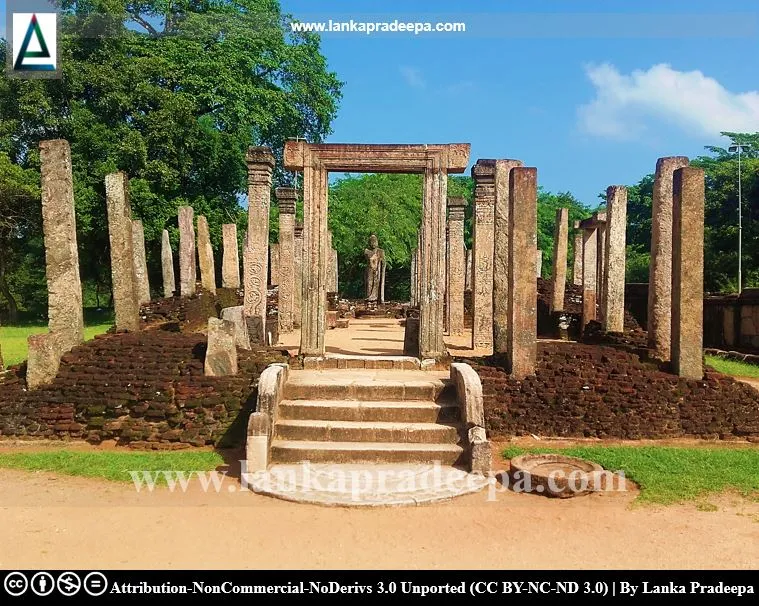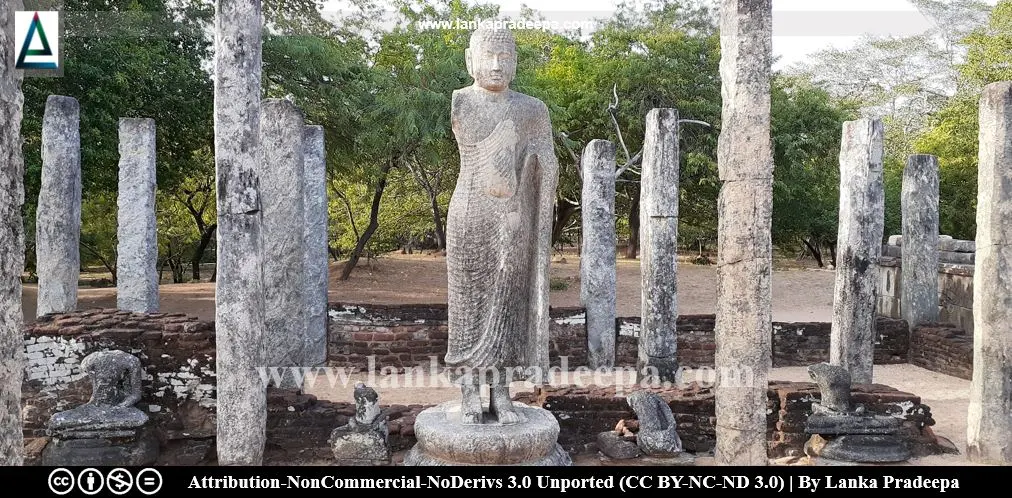
Atadage is a ruined relic shrine located on the premises of the Sacred Quadrangle (Puja Chaturasraya or Dalada Maluwa) in the Ancient City of Polonnaruwa, Sri Lanka.
History
This structure has been identified as the Temple of the Tooth Relic constructed by King Vijayabahu I [(1055-1110 A.D.) Chutiwongs et al., 2007; Jayasuriya, 2016; Ray, 1960]. The sacred Tooth Relic and the Bowl Relic of Buddha are believed to have been deposited on the upper floor of this building (Chutiwongs et al., 2007; Jayasuriya, 2016). As mentioned in the nearby Velaikkara Tamil Inscription, the crystal eyeballs of the Buddha statue which was on the ground floor of this building have been annually removed and anointed with corrylium (Chutiwongs et al., 2007).
The structure

Atadage is considered the oldest building located in the Sacred Quadrangle. The building is square in shape and an oblong vestibule projects from the front side which faces to south direction. Approximately the structure is 22.5 m in length and 25.5 m in breadth (Wikramagamage, 2004). The stone pillars at the entrance part have been decorated with carvings (Jayasuriya, 2016).
Initially, it was a two-storied building and on the ground floor a standing Buddha statue (Jayasuriya, 2016; Wikramagamage, 2004). The upper floor was probably made of timber and had been supported by 54 stone pillars, each 8 ft. in height (Ray, 1960). This upper floor was accessed through a granite staircase and a few steps of it still remain at the site.
Initially, it was a two-storied building and on the ground floor a standing Buddha statue (Jayasuriya, 2016; Wikramagamage, 2004). The upper floor was probably made of timber and had been supported by 54 stone pillars, each 8 ft. in height (Ray, 1960). This upper floor was accessed through a granite staircase and a few steps of it still remain at the site.
The standing Buddha of Atadage
This image is the central and the main image of the ground floor and it is 2.7 m (8 ft. 8 in.) in height (Chutiwongs et al., 2007). Although it is placed in the Atadage built during the reign of King Vijayabahu I (1055-1110 A.D.), the stylistic comparison with other images of the type as at Medirigiriya, Menik Vehera and Pabalu Vehera indicates that this Buddha image may be a creation of the 8th century A.D. (Chutiwongs et al., 2007). It is possible to assume that this image which had been sculpted in earlier was placed in the Atadage shrine by the king (Chutiwongs et al., 2007). The Velaikkara Tamil Inscription which stands near the Atadage reveals that this statue played a significant role in ritual worship, particularly the ritual of anointing the eye [(Netramangallaya) Chutiwongs et al., 2007].
Near the Atadage is the Velaikkara inscription inscribed in Grantha, Tamil and Sinhala scripts. According to the inscription, the Tooth Relic which was in the custody of Rajaguru Mugalan Thera had been deposited here and its protection was entrusted to the Velaikkara soldiers who were the hired guards of the king (Wickremasinghe, 1928). Also, this is the place where the first anointment ceremony (of Vijayabahu) was held (Wickremasinghe, 1928). The inscription further reveals that Atadage was the house of a colossal statue of Buddha in which is held annually the ceremony of unloosing the sacred eyes (of the Buddha statue) and applying collyrium to them (Wickremasinghe, 1928).


.
References
1) Chutiwongs, N.; Prematilleke, L.; Silva, R., 2007. Sri Lanka Murthi: Buddha (Sri Lanka Sculpture: Buddha). Central Cultural Fund. Ministry of Cultural Affairs. pp.62-63.
2) Jayasuriya, E., 2016. A guide to the Cultural Triangle of Sri Lanka. Central Cultural Fund. ISBN: 978-955-613-312-7. p.76.
3) Ray, H. C. (Editor in Chief), 1960. University of Ceylon: History of Ceylon (Vol 1, part II). Ceylon University Press. p.434.
4) Wikramagamage, C., 2004. Heritage of Rajarata: Major Natural, Cultural and Historic sites: Colombo. Central Bank of Sri Lanka. p. 211.
5) Wickremasinghe, D. M. D. Z., 1928. Epigraphia Zeylanica: Being lithic and other inscriptions of Ceylon (Vol, II). Published for the government of Ceylon by Humphrey Milford. pp.242-255.
4) Wikramagamage, C., 2004. Heritage of Rajarata: Major Natural, Cultural and Historic sites: Colombo. Central Bank of Sri Lanka. p. 211.
5) Wickremasinghe, D. M. D. Z., 1928. Epigraphia Zeylanica: Being lithic and other inscriptions of Ceylon (Vol, II). Published for the government of Ceylon by Humphrey Milford. pp.242-255.
Explore Other Nearby Attractions
Location Map (Google)
This page was last updated on 25 June 2023

